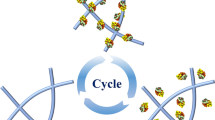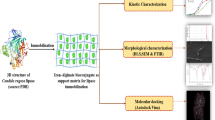Abstract
Aerogels prepared from aqueous dispersions of anionic and cationic cellulose nanofibrils (CNFs) were investigated as solid supports for enzymes and silver nanoparticles and to elicit a sustained antibacterial effect. The imparted stabilization in dry conditions was studied with aerogels that were cast after mixing the enzymes with CNFs followed by dehydration (freeze-drying). The activity of lysozyme immobilized in the given CNF system was analyzed upon storage in liquid and air media. In contrast with aqueous solutions of free, unbound enzyme, which lost activity after the first day, the enzyme immobilized physically in unmodified and cationic CNF presented better stability (activity for a longer time). However, the enzyme activity was reduced in the case of anionic CNF, which was prepared by TEMPO-mediated oxidation (TO-CNF). Both humidity and temperature reduced the stability of the enzyme immobilized in the respective CNF aerogel. The antibacterial activity of CNF aerogels carrying lysozyme was also tested against gram-negative and gram-positive bacteria. The results were compared with those obtained from CNF systems loaded with silver nanoparticles (AgNP) after in situ synthesis via UV reduction. Storage in cold or dry conditions preserved the activity and antibacterial performance of enzyme-loaded CNF aerogels. As expected, the lysozyme-containing aerogels showed lower inhibition than the AgNP-containing aerogel. In this latter case, the antibacterial activity depended on the concentration and size of the nanoparticles. Compared to unmodified CNF and TO-CNF, the aerogels prepared with cationic CNF, loaded with either lysozyme or AgNPs, showed remarkably better antibacterial activity. Similar experiments were conducted with horseradish peroxidase, which confirmed, to different degrees, the observations derived from the lysozyme systems. Overall, the results indicate that non-toxic and biodegradable CNF is a suitable support for bio-active materials and is effective in protecting and retaining enzymatic and antibacterial activities.





Similar content being viewed by others
References
Abdelgawad AM, Hudson SM, Rojas OJ (2014) Antimicrobial wound dressing microfiber mats from multicomponent (chitosan/silver-NPs/polyvinyl alcohol) systems. Carbohydr Polym 100:166–178
An J, Zhang H, Zhang J, Zhao Y, Yuan X (2009) Preparation and antibacterial activity of electrospun chitosan/poly (ethylene oxide) membranes containing silver nanoparticles. Colloid Polym Sci 287:1425–1434
Arcot LR, Uddin KMA, Chen X, Xiang W, Xianming K, Johansson LS, Ras RHA, Rojas OJ (2015) Paper-based plasmon-enhanced protein sensing by controlled nucleation of silver nanoparticles on cellulose. Cellulose 6:4027–4034
Barbiroli A, Bonomi F, Capretti G, Iametti S, Manzoni M, Piergiovanni L, Rollini M (2012) Antimicrobial activity of lysozyme and lactoferrin incorporated in cellulose-based food packaging. Food Control 26:387–392
Berndt S, Wesarg F, Wiegand C, Kralisch D, Muller FA (2013) Antimicrobial porous hybrids consisting of bacterial nanocellulose and silver nanoparticles. Cellulose 20:771–783
Cai J, Liu S, Feng J, Kimura S, Wada M, Kuga S, Zhang L (2012) Cellulose–silica nanocomposite aerogels by in situ formation of silica in cellulose gel. Angew Chem 124(9):2118–2121
Cho KH, Park JE, Osaka T, Park SG (2005) The study of antimicrobial activity and preservative effects of nanosilver ingredient. Electrochim Acta 51:956–960
Dong H, Snyder JF, Tran DT, Leadore JL (2013) Hydrogel, aerogel and film of cellulose nanofibrils functionalized with silver nanoparticles. Carbohydr Polym 95:760–767
Feng QL, Wu J, Chen GQ, Cui FZ, Kim TN, Kim JOA (2000) Mechanistic study of the antibacterial effect of silver ions on Escherichia coli and Staphylococcus aureus. J Biomed Mater Res 52:662–668
Goli K, Gera N, Liu X, Rao B, Rojas OJ, Genzer J (2013) Generation and properties of antibacterial coatings based on electrostatic attachment of silver nanoparticles to protein-coated polypropylene fiber. ACS Appl Mater Interfaces 5:5298–5306
Guilminot E, Fischer F, Chatenet M, Rigacci A, Berthon-Fabry S, Achard P, Chainet E (2007) Use of cellulose-based carbon aerogels as catalyst support for PEM fuel cell electrodes: electrochemical characterization. J Power Sources 166:104–111
Hashem M, Hauser PJ, Smith B (2003) Reaction efficiency for cellulose cationization using 3-chloro-2-hydroxypropyl trimethyl ammonium chloride. Text Res J 73:1017–1023
Hernandez K, Fernandez-Lafuente R (2011) Control of protein immobilization: coupling immobilization and site-directed mutagenesis to improve biocatalyst or biosensor performance. Enzyme Microb Technol 48:107–122
Hubbe MA, Hubbe Rojas OJ, Lucia LA, Jung TM (2007) Consequences of the nanoporosity of cellulosic fibers on their streaming potential and their interactions with cationic polyelectrolytes. Cellulose 14:655–671
Hughey VL, Johnson EA (1987) Antimicrobial activity of lysozyme against bacteria involved in food spoilage and food-borne disease. Appl Microbiol Biotechnol 53(9):2165–2170
Hwang ET, Gu MB (2013) Enzyme stabilization by nano/microsized hybrid materials. Eng Life Sci 1:49–61
Isogai A, Kato Y (1998) Preparation of polyuronic acid from cellulose by TEMPO-mediated oxidation. Cellulose 5:153–164
Ivan S, Branka SS (2004) Silver nanoparticles as antimicrobial agent: a case study on E. coli as a model for gram negative bacteria. J Colloid Interface Sci 275:177–182
Jesionowski T, Zdarta J, Krajewska B (2014) Enzyme immobilization by adsorption: a review. Adsorption 20:801–821
Johnson J, Ghosh A, Lannutti J (2007) Microstructure-property relationships in a tissue-engineering scaffold. J Appl Polym Sci 104:2919–2927
Lokanathan AR, Uddin KMA, Rojas OJ, Laine J (2014) Cellulose nanocrystal-mediated synthesis of silver nanoparticles: role of sulfate groups in nucleation phenomena. Biomacromol 15:373–379
Martins NCT, Freire CSR, Pinto RJB, Fernandes SCM, Neto CP, Silvestre AJD, Causio J, Baldi G, Sadocco P, Trindade T (2012) Electrostatic assembly of Ag nanoparticles onto nanofi brillated cellulose for antibacterial paper products. Cellulose 19:1425–1436
Mehrez EE-N, Eisa W, Abdelgawad AM, Rojas OJ (2017) Clean and high-throughput production of silver nanoparticles mediated by soy protein via solid state synthesis. J Clean Prod 144:501–510
Mogensen KB, Kneipp K (2014) Size-dependent shifts of plasmon resonance in silver nanoparticle films using controlled dissolution: monitoring the onset of surface screening effects. J Phys Chem C 118:28075–28083
Nogi M, Iwamoto S, Nakagaito AN, Yano H (2009) Optically transparent nanofiber paper. Adv Mater 21:1595–1598
Percival SL, Bowler PG, Russell D (2005) Bacterial resistance to silver in wound care. J Hosp Infect 60:1–7
Piletsky S, Piletska E, Bossi A, Turner N, Turner A (2003) Surface functionalization of porous polypropylene membranes with polyaniline for protein immobilization. Biotechnol Bioeng 82:86–92
Saito T, Nishiyama Y, Putaux JL, Vignon M, Isogai A (2006) Homogeneous suspensions of individualized microfibrils from TEMPO-catalyzed oxidation of native cellulose. Biomacromol 7:1687–1691
Saito T, Kimura S, Nishiyama Y, Isogai A (2007) Cellulose nanofibers prepared by TEMPO-mediated oxidation of native cellulose. Biomacromol 8:2485–2491
Sambhy V, MacBride MM, Peterson BR, Sen A (2006) Silver bromide nanoparticle/polymer composites: dual action tunable antimicrobial materials. J Am Chem Soc 128:9798–9808
Sehaqui H, Liu A, Zhou Q, Berglund LA (2010) Fast preparation procedure for large, flat cellulose and cellulose/inorganic nanopaper structures. Biomacromol 11(9):2195–2198
Sehaqui H, Zhou Q, Ikkala O, Berglund LA (2011) Strong and tough cellulose nanopaper with high specific surface area and porosity. Biomacromol 12:3638–3644
Sheldon RA (2007) Enzyme immobilization: the quest for optimum performance. Adv Synth Catal 49:1289–1307
Sheldon RA, Pelt SV (2013) Enzyme immobilisation in biocatalysis: why, what and how? Chem Soc Rev 42:6223–6225
Son WK, Youk JH, Park WH (2006) Antimicrobial cellulose acetate nanofibers containing silver nanoparticles. Carbohydr Polym 65:430–434
Spahn C, Minteer SD (2008) Enzyme immobilization in biotechnology. Recent Pat Eng 2:195–200
Sundarrajan S, Ramakrishna S (2007) Fabrication of nanocomposite membranes from nanofibers and nanoparticles for protection against chemical warfare stimulants. J Mater Sci 42:8400–8407
Syverud K, Stenius P (2009) Strength and barrier properties of MFC films. Cellulose 16:75–85
Taniguchi T, Okamura K (1998) New films produced from microfibrillated natural fibres. Polym Int 47(3):291–294
Uddin KMA, Lokanathan AR, Liljeström A, Chen X, Rojas OJ, Laine J (2014) Silver nanoparticle synthesis mediated by carboxylated cellulose nanocrystals. Green Mater 2:183–192
Wang Z, Hauser PJ, Laine J, Rojas OJ (2011) Multilayers of low charge density polyelectrolytes on thin films of carboxymethylated and cationic cellulose. J Adhesion Sci Technol 25:643–660
Wang J, Yiu B, Obermeyer J, Filipe CDM, Brennan JD, Pelton R (2012) Effects of temperature and relative humidity on the stability of paper-immobilized antibodies. Biomacromol 13:559–564
Wright JB, Lam K, Hansen D, Burrell RE (1999) Efficacy of topical silver against fungal burn wound pathogens. Am J Infect Control 27(4):344–350
Yabuki S (2014) Supporting materials that improve the stability of enzyme membranes. Anal Sci 30:213–217
Yan J, Abdelgawad AM, El-Naggar ME, Rojas OJ (2016) Antibacterial activity of silver nanoparticles synthesized In-situ by solution spraying onto cellulose. Carbohydr Polym 147:500–508
Yano H, Nakahara S (2004) Bio-composites produced from plant microfiber bundles with a nanometer unit web-like network. J Mater Sci 39:1635–1638
Ye SH, Watanabe J, Iwasaki Y, Ishihara K (2003) Antifouling blood purification membrane composed of cellulose acetate and phospholipid polymer. Biomaterials 24:4143–4152
Yoon J, Park JM, Jung SK, Kim KY, Kim YH, Min J (2009) Characterization of antimicrobial activity of the lysosomes isolated from Saccharomyces cerevisiae. Curr Microbiol 59:48–52
Zhang Y, Nypelö T, Salas C, Arboleda J, Hoeger IC, Rojas OJ (2013) Cellulose nanofibrils: from strong materials to bioactive surfaces. J Renew Mater 1(3):195–211
Acknowledgments
The authors are grateful for funding support by the Academy of Finland (AF) through Project 295007, Nanocellulose Cyber-Physical Microsystems (ICT 2023: Advanced microsystems) as well as AF’s Centres of Excellence Programme (2014–2019), under Project 264677 “Molecular Engineering of Biosynthetic Hybrid Materials Research” (HYBER). This work made use of the Aalto University Nano microscopy Center.
Author information
Authors and Affiliations
Corresponding authors
Electronic supplementary material
Below is the link to the electronic supplementary material.
Rights and permissions
About this article
Cite this article
Uddin, K.M.A., Orelma, H., Mohammadi, P. et al. Retention of lysozyme activity by physical immobilization in nanocellulose aerogels and antibacterial effects. Cellulose 24, 2837–2848 (2017). https://doi.org/10.1007/s10570-017-1311-0
Received:
Accepted:
Published:
Issue Date:
DOI: https://doi.org/10.1007/s10570-017-1311-0




